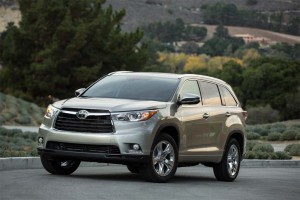
Cold weather and icy roads are convincing many buyers to seek out AWD-equipped crossovers like this new Toyota Highlander.
The harsh winter weather that has enveloped much of the country this month – ice, snow and sub-zero temperatures crippling major metropolitan areas in the Midwest, Southeast and along the Atlantic Coast — has chased consumers out of showrooms.
It also appears to have led to a modest shift in what U.S. motorists have been buying, with more of an emphasis on crossovers and SUVs, in particular, and all-wheel-drive models, in general.
Carmakers have been reluctant to make any predictions about the monthly sales with key markets such as Atlanta, Dallas, Washington D.C. and Chicago hit hard by combinations of ice, snow and severe cold. But preliminary numbers – with final sales totals due out next week – aren’t promising. If so, it would prove to be the second month in a row with the industry in the minus column, along with the temperature, a sharp reversal from last year’s booming automotive recovery.
Nevertheless, February’s totals could surprise on the up side as sales are still showing signs of improvement from January and the first week of this month, according to a monthly sales forecast developed jointly by J.D. Power and LMC Automotive. In addition, attendance at auto shows has held steady across the U.S. – and there has long been a direct link between auto show attendance and sales in the months that follow.
(January car sales get the big chill.Click Here for the story.)
“Although severe weather impacted sales in early February, the negative effect should be somewhat mitigated since the majority of vehicle sales occur in the second half of the month,” said John Humphrey, senior vice president of the global automotive practice at J.D. Power.
Humphrey also noted that the underlying health of the industry remains strong as seen through a continuation of record average transaction prices.
(Click Here to see how you can keep the cold from cutting your fuel economy.)
J.D. Power expects the sales pace to increase toward the end of February, as vehicle buyers who delayed their purchase due to severe weather return to market, Humphrey said. Other contributors to an anticipated upswing in sales are the President’s Day holiday weekend and the promotional events that accompanied it.
“The industry is on track to reach its highest-ever average transaction price for the month of February, with prices exceeding $29,000,” Humphrey said. “This beats the previous record from February 2013 by more than $400.”
J.D. Power also expects consumer spending on new vehicles–the sum of retail sales multiplied by transaction price–to exceed $28.3 billion in February, also the highest for the month and an increase of nearly $1.7 billion from February 2013.
One factor contributing to the added spending may be a shift in what consumers have been buying. The shopping service Swapalease.com noted that “utility vehicles have been replacing certain car segments in many locations” over the last several months.
(Winter weather wreaking havoc with global auto production. Click Here for the story.)
While the upper midsize car segment remained the largest market niche this winter, at 14.3%, midsize and full-size crossovers were close behind, at 14.1% and 13.2%, respectively. Those two CUV segments were each up nearly a point of share compared to the same period the year before. There’s also anecdotal evidence from manufacturers that vehicles of all sorts equipped with all-wheel-drive are growing in demand.
Despite the initial slow start to the year, LMC Automotive’s forecast for total light-vehicle sales in 2014 remains at 16.2 million units, with retail light-vehicle sales of 13.3 million units.
“With the likelihood of fleet sales holding below 18% and modest retail sales increases, the absolute rate of growth could be lower than initially expected,” said Jeff Schuster, senior vice president of forecasting at LMC Automotive. “The auto industry needs to be prepared for slower but stable growth and increased competitive intensity, which will put pressure on the successful execution of launches this year.” he cautioned.
Vehicle production in North America in January–hampered by inclement weather in the southeastern United States–came in at 1.3 million units, flat from January 2013 but a 250,000 unit increase from December.
A slower-than-expected sales pace in January, combined with excess production in the fourth quarter of 2013, built a substantial increase in inventory from a days-supply perspective. Inventory started February at an 88-day supply, an increase of 24 days from the start of January. The Detroit Three combined supply level increased to 109 days, with an additional 92,000 units parked on dealer lots and storage locations. All other manufacturers, with the exception of Subaru, also had an increase in inventory for the month.
“While inventory levels are excessive at this point, demand during the spring selling season will help resolve the situation,” said Bill Rinna, senior manager of forecasting at LMC Automotive. “However, if inventory is not cleared out by June, production levels in the second half of the year are at risk.”
Given the current environment and risk, LMC Automotive has reduced its 2014 North American production forecast by nearly 100,000 units to 16.5 million units, a 2.5 percent increase from 2013. This is still the highest total since 2000.
(Paul A. Eisenstein contributed to this report.)
